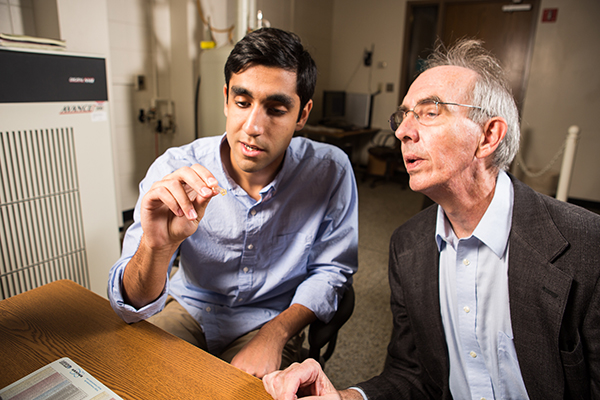Armin Mortazavi

Armin Mortazavi carefully removes the glass cuvette from a protective vial and gingerly places it in the magnetic resonance probe. He’s right to take care, because that tiny glass receptacle contains two solid weeks of work. Inside the cuvette, he’s packed 40 microthin glass plates that cradle 1.33 micro moles of identical alpha-helical peptide molecules, which he synthesized in an adjacent chemistry lab. Two out of the 23 amino acids on each peptide are tagged with deuterium (or “heavy hydrogen”) labels that will aid in magnetic resonance imaging.
Now, Armin inserts the probe into the magnetic resonance spectrometer, flips the switch, and waits 24-48 hours for results – the jagged peaks and valleys of nuclear magnetic resonance spectra, which he will analyze to understand how the peptides tilt and move within lipid bilayers that simulate cell membranes.
“It’s like doing an MRI on a molecule,” said Roger Koeppe, Distinguished Professor of chemistry and biochemistry, and Armin’s faculty mentor.
This painstaking work contributes to knowledge of the molecular properties of membrane proteins, which play a critical role in cell signaling, both for diseased states and basic biological functions. The Human Genome Project found that about 30 percent of proteins encoded by the human genome are membrane proteins; since this discovery, up to 50 percent of modern drugs have targeted membrane proteins. By providing fundamental understanding, this research could lead to ideas for treating neurological diseases such as Alzheimer’s or Parkinson’s.
“It could be useful in understanding how proteins aggregate, which is characteristic of some neurodegenerative diseases – but that’s long down the line at this point,” Armin said. “Our main purpose is to understand how they interact in the body.”
Armin is an honors chemistry and physics double major, a Bodenhamer Fellow, and the recipient of the Goldwater Scholarship, a national award that recognizes mathematics, science and engineering students planning careers in scientific research. His research builds on earlier work by honors student Kelsey Sparks, who studied the role aromatic rings play in the movement of the same family of peptides. Sparks was the first author on a paper published in 2014 in Biochemistry, a leading journal in the field.
Previous work in Koeppe’s lab found that a similar peptide helix might be unwound or “frayed” at the end. Armin has confirmed that there are multiple peptides that fray at the end, limiting their extent of motion and helping to anchor them within a lipid membrane.
“What Armin has found suggests that there may be more importance to the loops within membrane signaling proteins, which have largely been ignored up to now,” Koeppe said. “His work may point us in a new direction.”
Armin presented his work at the 2015 and 2016 meetings of the Biophysical Society and an article listing him as first author appeared in the March 2016 issue of a top European journal, ChemBioChem. His research was featured on the cover.
Koeppe has mentored more than 25 honors students, with six of them publishing their research.
“To this point, I’ve not had a student publish before they graduate,” he said. “Armin started research early, in his freshman year. He’s well organized, dedicated, hardworking, and he’s produced a lot of results.”
Medical school is next on the agenda. Armin is heading to Georgetown University School of Medicine this fall, supported by a generous scholarship, with an option to enter the MD/Ph.D. program after his first year. He’s considering surgery and oncology, but hopes to carve out time for the lab: “I really enjoy research, and want to continue with it and practice medicine, too.”